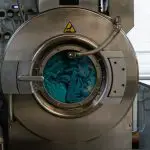When considering natural and synthetic dyes, you might wonder which option is truly more sustainable. Natural dyes are often praised for being biodegradable and eco-friendly, but they come with their own set of challenges, like potential habitat destruction. On the other hand, synthetic dyes are cheaper and provide consistent results but involve harmful chemicals. So, how do you weigh these factors in the context of sustainability? The answer isn’t as straightforward as it seems.
Table of Contents
Key Takeaways
- Natural dyes are biodegradable and have a smaller carbon footprint compared to synthetic dyes, which involve toxic chemicals and heavy metal compounds.
- The production of natural dyes is often more labor-intensive and can be more expensive, but eco-conscious consumers may prefer them despite the cost.
- Synthetic dye production consumes significant water and energy, contributing to environmental degradation and emissions from fossil fuels.
- Natural dyes pose fewer health risks as they are non-toxic and gentle on the skin, unlike synthetic dyes that can cause irritation and allergic reactions.
- Innovations in natural dyeing practices aim to reduce water usage and enhance sustainability, addressing the growing demand for eco-friendly products.
Environmental Impact of Natural and Synthetic Dyes
When you consider the environmental impact of dyes, it’s essential to recognize the stark differences between natural and synthetic options.
Natural dyes, derived from plants, minerals, or insects, often have a smaller carbon footprint. They typically require less energy to produce and are biodegradable, making them a more eco-friendly choice. However, sourcing some natural materials can lead to habitat destruction if not done sustainably.
Natural dyes offer an eco-friendly option with a smaller carbon footprint, but sustainable sourcing is crucial to prevent habitat destruction.
On the other hand, synthetic dyes, while offering a wider range of colors, often involve toxic chemicals and heavy metal compounds. Their production processes consume significant water and energy, contributing to pollution and ecological damage.
Ultimately, your choice of dye affects not only the product’s aesthetics but also its impact on the planet. Choose wisely for a sustainable future!
Health and Safety Considerations
When choosing between natural and synthetic dyes, it’s vital to take into account your health and safety.
Natural dyes often come with non-toxic benefits, reducing the risk of harmful chemical exposure.
On the other hand, synthetic dyes can pose significant health risks, making informed choices essential for your well-being.
Non-Toxic Benefits
While synthetic dyes may offer a wide range of colors, they often come with health risks that natural dyes can avoid. Choosing natural dyes not only benefits the environment but also guarantees a safer experience for you and your loved ones.
Here are some non-toxic benefits you can enjoy:
- Gentle on Skin: Natural dyes are less likely to cause allergic reactions or irritation, making them safer for sensitive skin.
- Chemical-Free: They’re derived from plants, minerals, and other natural sources, eliminating harmful synthetic chemicals.
- Biodegradable: Natural dyes break down easily, reducing environmental impact and promoting sustainability.
- Non-Carcinogenic: Unlike many synthetic options, natural dyes generally don’t contain toxic substances linked to cancer risk.
Embracing natural dyes is a step towards a healthier lifestyle!
Chemical Exposure Risks
Despite the many advantages of natural dyes, it’s important to acknowledge the potential risks associated with synthetic dyes. When you use synthetic dyes, you’re often exposed to harmful chemicals like azo compounds, formaldehyde, and heavy metals. These substances can cause skin irritation, allergic reactions, and even long-term health issues.
Additionally, the production of synthetic dyes often involves toxic waste that can contaminate water sources, affecting both you and the environment. Even if you’re not directly handling these dyes, the release of volatile organic compounds (VOCs) into the air can pose respiratory risks.
Sustainability Challenges in Dye Production
As the demand for vibrant colors in textiles and products grows, the sustainability challenges in dye production become increasingly apparent.
You need to take into account several factors when evaluating the sustainability of dyes:
- Water Consumption: Dye production often requires large amounts of water, leading to depletion of local water sources.
- Chemical Waste: Both natural and synthetic dyes can generate hazardous waste, which must be managed properly to avoid environmental contamination.
- Biodiversity Impact: Sourcing natural dyes can contribute to habitat destruction if not done sustainably.
- Carbon Footprint: Manufacturing synthetic dyes typically involves fossil fuels, raising concerns about greenhouse gas emissions.
Economic Viability of Natural vs. Synthetic Dyes
When you consider the economic viability of natural versus synthetic dyes, you’ll find that both have their unique advantages and challenges.
Natural dyes often require more labor-intensive processes and can be more expensive to produce, which might affect your bottom line. However, they can attract a niche market willing to pay a premium for eco-friendly products.
Natural dyes may be pricier and labor-intensive, yet they appeal to eco-conscious consumers seeking premium, sustainable options.
On the other hand, synthetic dyes are usually cheaper and easier to mass-produce, making them appealing for large-scale manufacturing. Their consistent quality can lead to fewer production errors and waste.
Ultimately, your choice will depend on your target audience, production scale, and commitment to sustainability. Balancing cost and environmental impact is key in making the best decision for your business.
Future Directions for Dyeing Practices
The future of dyeing practices is poised to evolve markedly as sustainability becomes a priority for consumers and manufacturers alike.
You can expect several exciting developments in this field:
- Biodegradable Dyes: Innovations in natural dye formulations will lead to more biodegradable options, reducing environmental impact.
- Waterless Dyeing Technologies: Expect advancements in technology that minimize or eliminate water usage in dyeing processes, conserving this precious resource.
- Recycling of Dye Waste: Manufacturers will increasingly focus on recycling dye waste, transforming it into new products, thereby closing the loop.
- Innovative Plant-Based Dyes: Research will continue into new plant-based dye sources, expanding the palette and sustainability of textiles.
These directions promise a more sustainable future for the dyeing industry, catering to eco-conscious consumers.
Consumer Awareness and Its Role in Sustainability
How can consumer awareness drive the shift toward sustainable dyeing practices? When you become informed about the environmental impact of dyeing, your choices can influence brands to adopt more sustainable methods.
By prioritizing products made with natural dyes, you signal to manufacturers that eco-friendly practices matter. This demand can push companies to innovate and reduce their reliance on harmful synthetic dyes.
Moreover, sharing your knowledge with others amplifies this effect. When your friends and family understand the benefits of sustainable dyes, they’re more likely to make informed choices too.
Your voice matters in the market. By supporting brands that embrace sustainability, you contribute to a healthier planet and encourage more businesses to follow suit. Together, we can create meaningful change.
Frequently Asked Questions
How Do Natural Dyes Compare in Cost to Synthetic Dyes?
When you compare natural dyes to synthetic dyes, you’ll often find that natural dyes can be more expensive due to sourcing and processing. However, the overall cost can vary depending on availability and production methods.
What Are Common Sources for Natural Dyes?
You’ll find common sources for natural dyes in plants, fruits, vegetables, and even insects. For instance, indigo comes from the indigo plant, while cochineal provides vibrant red hues. Exploring these options can spark your creativity!
Can Natural Dyes Be Used for All Fabrics?
Yes, natural dyes can be used on many fabrics, but their effectiveness varies. You’ll find they work best on natural fibers like cotton, silk, and wool, while synthetic fibers often require specific treatments for ideal results.
How Long Do Natural Dyes Typically Last?
Natural dyes may not always stand the test of time, but with proper care, they can last several years. You’ll find that factors like fabric type and exposure to light greatly influence their longevity.
Are There Any Cultural Implications of Using Natural Dyes?
When you explore natural dyes, you’ll discover deep cultural connections. They often reflect traditions, heritage, and local practices, showcasing unique identities. Using these dyes can celebrate craftsmanship and foster appreciation for cultural significance in textile art.







